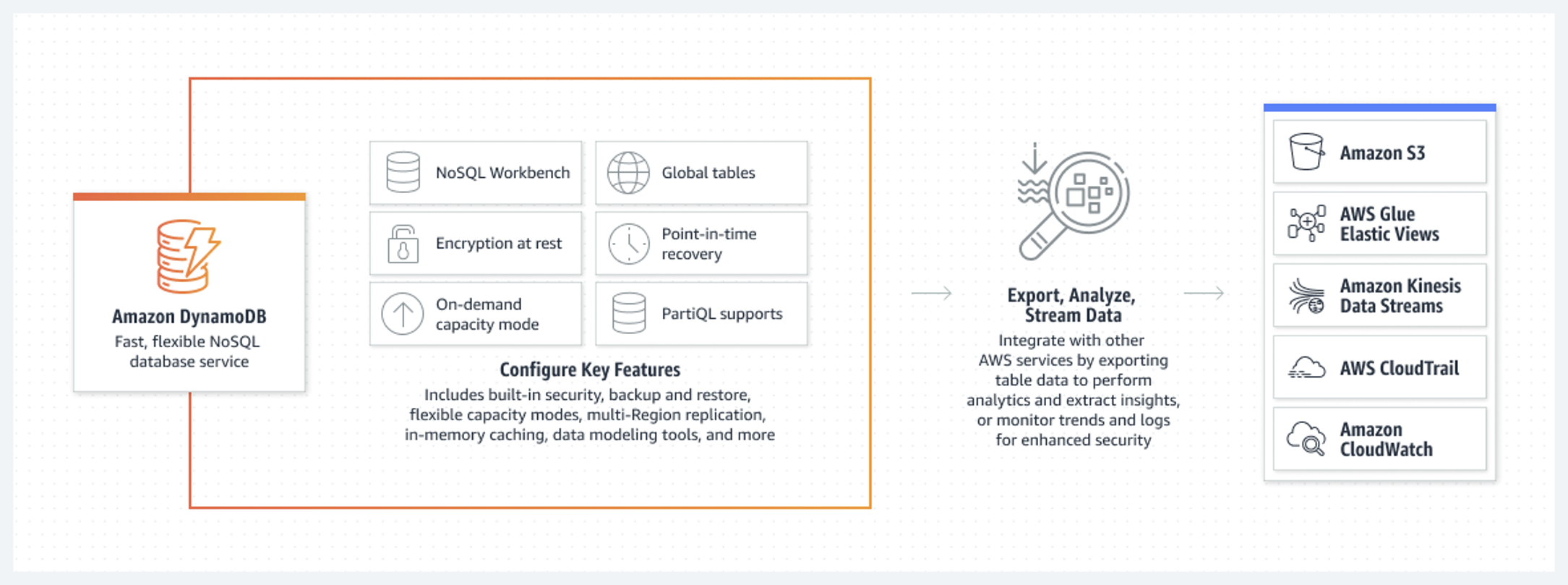- Home
- About
- Consulting
- Services
- Minfy Labs
- Industries
- Resonances
- Careers
- Contact
Amazon DynamoDB is a fully managed NoSQL database service that provides fast and predictable performance with seamless scalability. DynamoDB lets you offload the administrative burdens of operating and scaling a distributed database so that you don't have to worry about hardware provisioning, setup, configuration, replication, software patching, or cluster scaling. DynamoDB also offers encryption at rest, which eliminates the operational burden and complexity involved in protecting sensitive data.
With DynamoDB, you can create database tables that can store and retrieve any amount of data and serve any level of request traffic. You can scale up or scale down your tables' throughput capacity without downtime or performance degradation. You can use the AWS Management Console to monitor resource utilization and performance metrics.
DynamoDB provides on-demand backup capabilities. It allows you to create full backups of your tables for long-term retention and archival for regulatory compliance needs.
You can create on-demand backups and enable point-in-time recovery for your Amazon DynamoDB tables. Point-in-time recovery helps protect your tables from accidental write or delete operations. With point-in-time recovery, you can restore a table to any point in time during the last 35 days.
DynamoDB helps deleting expired items from tables automatically that reduces storage use as well as the cost of storing irrelevant data.
Amazon DynamoDB is a fully managed, serverless, key-value NoSQL database designed to run high-performance applications at any scale. DynamoDB offers built-in security, continuous backups, automated multi-region replication, in-memory caching, and data import and export tools.

The diagram shows the core features of Amazon DynamoDB and its integrations with other AWS services. The three sections are displayed from left to right.
The first section has an illustration of the DynamoDB service icon within a box titled “Configure Key Features”. Six boxes are displayed in two columns with three rows each with the following features represented per box:
• "NoSQL Workbench" is in the top-left box in the first column
• "Encryption at Rest" is in the middle-left box
• "On-demand capacity mode" is in the bottom-left box
• "Global Tables" is in the top-right box in the second column
• "Point-in-Time Recovery" is in the middle-right box and
• "PartiQL Supports" is in the right-bottom box.
Below the six boxes, each containing a feature, and below the heading “Configure Key Features”, is a sentence listing additional DynamoDB features.
The second section has an illustration of a magnifying glass looking at blocks of data. There is a left arrow signifying data coming from DynamoDB and a right arrow signifying data going into AWS services that DynamoDB integrates with. Under the magnifying glass is a headline of “Export, Analyze, Stream Data” with a sentence that explains the types of functions that can be performed when integrating with other AWS services.
The third section is a box containing five smaller boxes within it, representing the five services that DynamoDB integrates with. The top box contains “Amazon S3”, the second box contains “AWS Glue Elastic Views”, the third box contains “Amazon Kinesis Data Streams”, the fourth box contains “AWS CloudTrail” and the fifth and final box contains “Amazon CloudWatch”.
DynamoDB provides virtually unlimited storage, and users can utilize it as required. In addition, it provides flexibility for the developers to only scale the database once the application starts accumulating data and not at the start. So, there is no need to have reserved storage when deploying the database.
By default, DynamoDB replicates table data into three (3) availability zones within a single region. It allows you to easily recover from any disaster and avoid service disruptions.
In addition, you can use DynamoDB global tables to replicate data across multiple regions (different geolocations) to achieve a higher level of redundancy.
The data replication takes place in near real-time to ensure seamless failover during a disaster while minimizing the amount of data lost.
DynamoDB is a fully managed NoSQL database service that does not require users to maintain any underlying infrastructures. Instead, it allows users to focus on developing their applications. At the same time, AWS handles tedious tasks such as high availability, database upgrades, and even maintaining the physical infrastructure within their data centers.
The DynamoDB database service provides clear, demonstrated security guidelines while adhering to multiple globally recognized regulatory compliance like PCI DSS, HIPAA, and NIST.
It is important to note that even though AWS secures the infrastructure of the database service, DynamoDB depends on the shared responsibility model and expects its users to securely configure their DynamoDB instances using the required security controls.
DynamoDB also supports integration with AWS Identity and Access Management to enforce fine-grained access control to the database while encrypting the data with industry-standard algorithms.
One of the most talked about advantages of DynamoDB is its single-digit response times. These response times are significant since DynamoDB ensures lightning-fast response times at any scale.
However, if these response times are not fast enough, you can use the DynamoDB Accelerator (DAX) caching mechanism to decrease the latency of the DynamoDB operations.
Lets discuss your requirements to take your business to a next level of productivity and services.
© 2022 Minfy™. Minfy Technologies. All rights reserved. | Privacy Policy | Terms and Conditions
This website stores cookie on your computer. These cookies are used to collect information about how you interact with our website and allow us to remember you. We use this information in order to improve and customize your browsing experience and for analytics and metrics about our visitors both on this website and other media. To find out more about the cookies we use, see our Privacy Policy. If you decline, your information won’t be tracked when you visit this website. A single cookie will be used in your browser to remember your preference not to be tracked.
 Go to Swayam
Go to Swayam